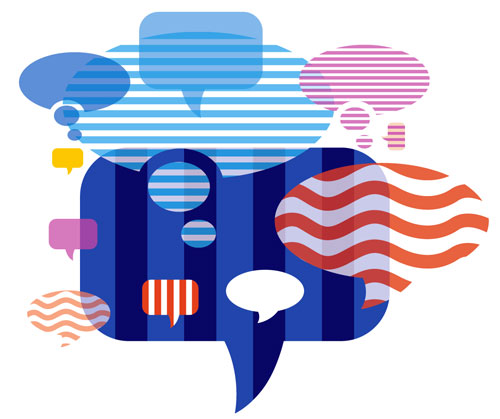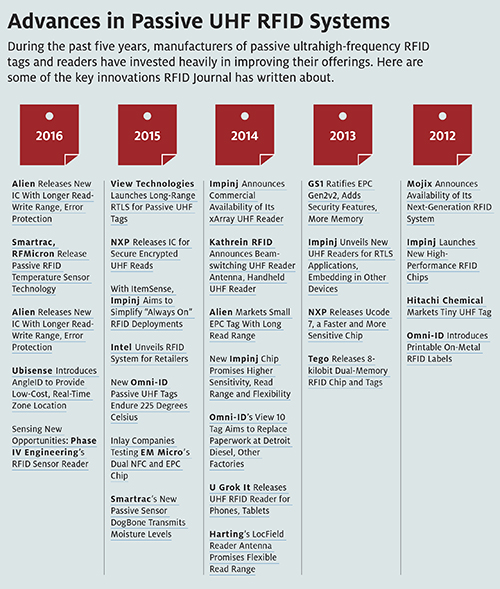During the past five years, passive ultrahigh-frequency radio frequency identification systems have improved markedly. The read range has increased significantly due to development of more sensitive microchips and better antenna design. Security features have been added to prevent cloning and eavesdropping on tag-to-reader communication. And innovations have enabled tags to be read on metal products and even to be embedded in metal for tracking items such as medical devices. In fact, a recent report from the European EPC Competence Center, a Germany-based provider of RFID services, found that on-metal tags are becoming smaller and increasing in sensitivity and reliability (see EECC Benchmark Study Finds UHF Tag Performance Better Than Ever).
This raises two important questions. Do passive systems need further improvement and, if so, can they get any better?

The answer to the first question is certainly yes. Passive UHF RFID technology works well for many applications, but there are still some things end users would like it to do or do better. These things, if achieved, would dramatically boost adoption levels.
1. Capture tag data more consistently.
RFID systems are great for reading tags quickly. A single store associate can take inventory of 10,000 apparel items in two hours with a handheld RFID reader. It would take the same associate approximately 50 hours with a bar-code scanner, and the accuracy would not be as high.
Still, retailers would like to move to fixed RFID readers in stores and read all the tags on all the items on their shelves. Today’s overhead readers are typically able to read only 50 percent to 90 percent of the tags. That’s because tags on densely packed items often block the reader signal from reaching tags on other items behind or below them. Getting the read accuracy on overhead fixed readers up to 95 percent accuracy levels or higher would boost retail adoption.
2. Exclude extraneous reads.
In some cases, passive RFID readers are too good at capturing tag data. Often, a forklift truck reader will read tags on items on shelves, rather than just those on the forklift truck. And handheld readers sometimes capture tags on items on shelves the associate does not intend to inventory. Many end users say they would like to see the passive UHF read field be more defined or have readers use other methods to exclude tags they do not want to read.
3. Make the technology more plug-and-play.
At an RFID Journal event in 2003, Linda Dillman, then CIO of Walmart, showed a photo of the back of a smart shelf the retailer was trialing in one store—in the picture, a jumble of boxes with wires and cables was going in every direction. “This is not deployable in stores,” Dillman said. The technology has improved since then. Readers come in neat little boxes and can have integrated or external antennas. Sleek portals often hide all the hardware.
But passive UHF systems frequently require some tweaking of power levels and careful positioning of reader antennas to optimize the read field. Most end users would like to be able to place a reader in a ceiling, doorway or wall and begin collecting data. We’re not quite there yet.
4. Reduce the cost.
Tag prices have come down significantly over the years. Passive UHF inlays are now available for 7 or 8 cents in large volumes. This helps make the technology ideal for tracking high-value goods, such as clothing and pharmaceuticals. But there are many low cost, low-margin items, particularly in the food and grocery sector, that cannot support the cost of a 7-cent tag.
Are any of these areas likely to improve? A great deal of research is being conducted at universities worldwide and in the research and development departments of RFID companies.
In the May-June 2016 issue of RFID Journal magazine, for example, we wrote about a research project by Shadi Ebrahimi-Asl, a Ph.D. student at the Missouri University of Science and Technology, in Rolla, Mo., that could have a profound impact on the ability to read tags in close proximity to one another. Ebrahimi-Asl realized that energy from the reader antenna reflects off the antennas of passive tags even when they are not communicating with the reader. This creates interference that makes it harder for the reader to receive a signal from the tag with which it’s communicating (see ‘Invisible’ Antennas).
Ebrahimi-Asl knew that the induced electrical charge on an antenna can be reduced to reach the antenna’s minimum backscatter state (a theoretical state known as an “invisible” antenna). She built a backscatter antenna in the lab and changed the load on it to make it remain invisible to the reader. She demonstrated that by doing so, she could more easily read a tag close behind it. This capability, if built into passive UHF tags, could make it easier to read tags spaced closely together. It would also increase the read range of passive UHF readers by reducing interference from multiple tags in the read field. In this issue, we write about research being conducted at North Carolina State University to develop chips that would be 25 percent smaller and therefore cheaper to produce.
Extraneous reads are likely to be addressed with both hardware and software. A number of vendors have introduced antennas for fixed RFID readers that more tightly control the read zone. It’s also likely that improvements in algorithms will enable software to filter out unwanted reads more effectively than it can today.
Intel has been one of the first to market with a reader designed to be easier to install. Its Retail Sensor Platform consists of UHF RFID readers with integrated antennas, wired to an Intel Gateway device that forwards the data to a server. The platform also includes an Intel application programming interface (API) that allows RFID systems integrators to write software for linking the RFID data to a store’s existing software. Intel says the system is up to 40 percent faster and easier to install than a conventional reader and antenna deployment.
Expect passive UHF RFID systems to improve in all these ways during the next five years.
Illustrations: iStockphoto


